bonnet Hyundai Coupe 2002 Owner's Manual
[x] Cancel search | Manufacturer: HYUNDAI, Model Year: 2002, Model line: Coupe, Model: Hyundai Coupe 2002Pages: 140, PDF Size: 1.45 MB
Page 12 of 140

CONTROLS AND EQUIPMENT
1- 4
HGK099-D
B040G01GK-GAT Central Door Lock The central door locking is operated by pushing the driver's door lock switch toward the front or rear of the vehicle. If the passenger door is open when the switch is pushed, the door will remain locked when closed. NOTE:
o When pushing the switch toward the rear, all doors will unlock.When pushing the switch toward the front, all doors will lock.
o When the door is unlocked, the red mark on the switch is visible.
o The central door locking is operated by turning the key (driver's door only) toward the front or rear of the vehicle. B070A01A-AAT THEFT-ALARM SYSTEM (Not all models) This system is designed to provide protection from unauthorized entry into the car. This system is operated in three stages: the first is the "Armed" stage, the second is the "Alarm" stage, and the third is the "Disarmed" stage. If triggered, the system provides an audible alarm with blinking of the turn signal light.
B070C01GK-EAT Alarm Stage The alarm will be activated if any of the following occur while the car is parked and the system is armed.
1) A front door is opened without using the keyor the transmitter.
2) The hatchabck door is opened without using the key.
3) The engine bonnet is opened.The siren will sound and the turn signal lamp will blink continuously for 30 seconds. To turn off the system, unlock the door with the transmitter. CAUTION: Avoid trying to start the engine while the system is armed.
B070B01GK-EAT Armed Stage Park the car and stop the engine. Arm the system as described below.
1) Remove the ignition key from the ignition
switch.
2) Make sure that the engine bonnet and hatchabck door are locked.
3) Lock the doors using the transmitter of the keyless entry system.
After completion of the steps above, the turn signal lamp will blink once to indicate that the system is armed. NOTE:
1) If any door, hatchabck door or engine bonnet remains open, the system will notbe armed.
2) If this happens, rearm the system as de-
scribed above. 3) Once the system is armed, only the
hatchabck door may be unlocked using the key without disarming the system.
4) If you don't open any doors within 30 seconds after locked the all doors by the key or the transmitter, the system is armed automatically.
CAUTION: Do not arm the system until all passengers have left the car. If the system is armed while a passenger(s) remains in the car, the alarm may be activated when the remaining passenger(s) leaves the car.
Page 52 of 140
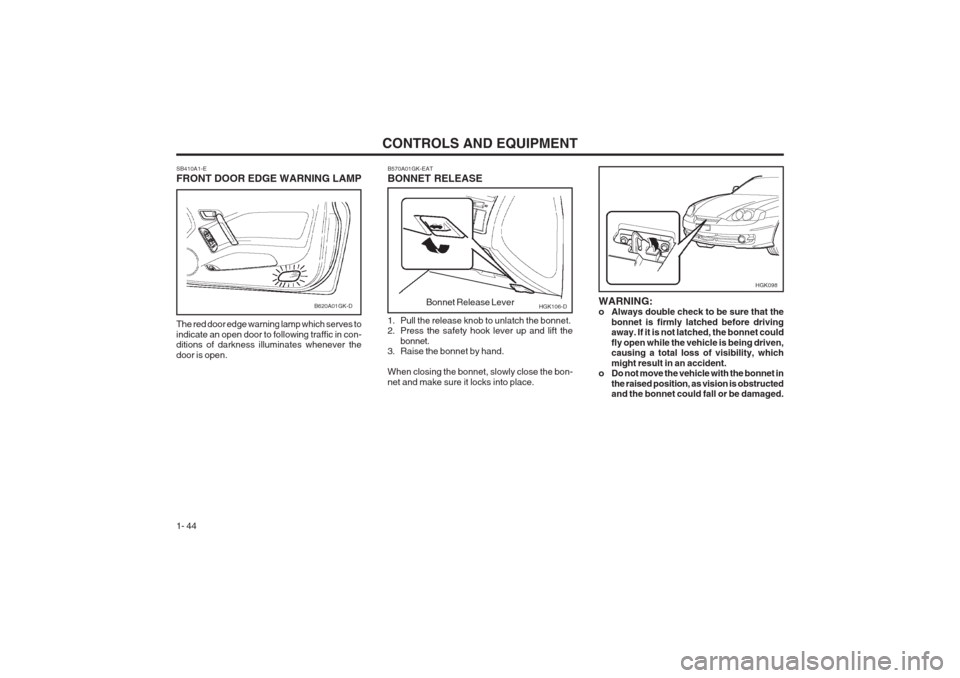
CONTROLS AND EQUIPMENT
1- 44
SB410A1-E FRONT DOOR EDGE WARNING LAMP The red door edge warning lamp which serves to indicate an open door to following traffic in con- ditions of darkness illuminates whenever the door is open.
B620A01GK-DWARNING:
o Always double check to be sure that the
bonnet is firmly latched before drivingaway. If it is not latched, the bonnet could fly open while the vehicle is being driven, causing a total loss of visibility, which might result in an accident.
o Do not move the vehicle with the bonnet in
the raised position, as vision is obstructed and the bonnet could fall or be damaged.
B570A01GK-EAT BONNET RELEASE
1. Pull the release knob to unlatch the bonnet.
2. Press the safety hook lever up and lift the
bonnet.
3. Raise the bonnet by hand. When closing the bonnet, slowly close the bon- net and make sure it locks into place.HGK106-DBonnet Release Lever
HGK098
Page 90 of 140
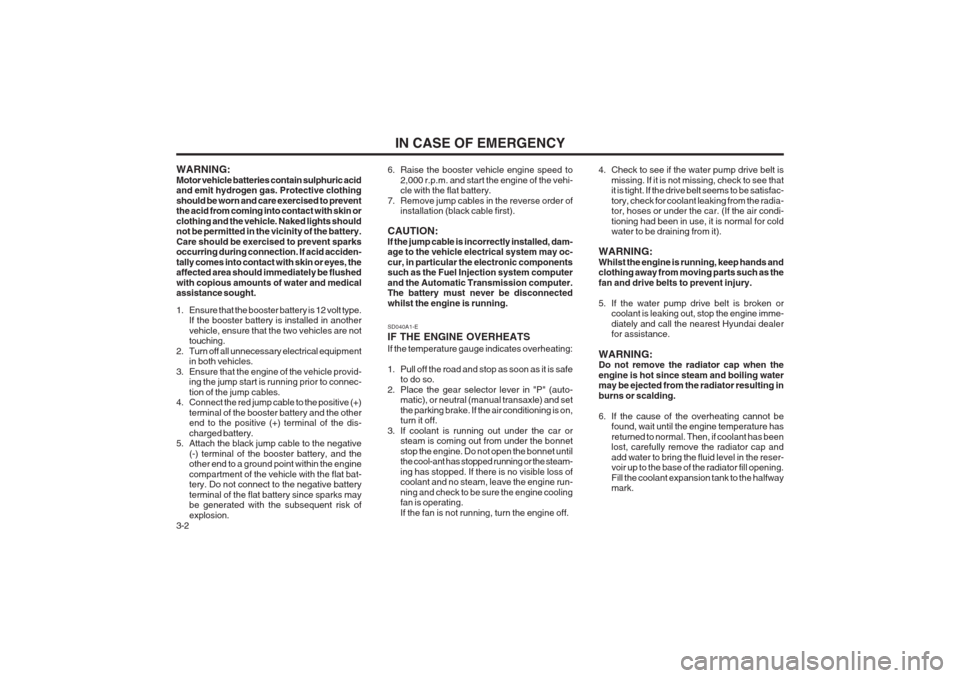
IN CASE OF EMERGENCY
3-2 4. Check to see if the water pump drive belt is
missing. If it is not missing, check to see that it is tight. If the drive belt seems to be satisfac- tory, check for coolant leaking from the radia- tor, hoses or under the car. (If the air condi- tioning had been in use, it is normal for cold water to be draining from it).
WARNING: Whilst the engine is running, keep hands and clothing away from moving parts such as the fan and drive belts to prevent injury.
5. If the water pump drive belt is broken or coolant is leaking out, stop the engine imme- diately and call the nearest Hyundai dealer for assistance.
WARNING:Do not remove the radiator cap when the engine is hot since steam and boiling water may be ejected from the radiator resulting in burns or scalding.
6. If the cause of the overheating cannot be found, wait until the engine temperature has returned to normal. Then, if coolant has been lost, carefully remove the radiator cap and add water to bring the fluid level in the reser- voir up to the base of the radiator fill opening. Fill the coolant expansion tank to the halfway mark.
WARNING: Motor vehicle batteries contain sulphuric acid and emit hydrogen gas. Protective clothing should be worn and care exercised to prevent the acid from coming into contact with skin or clothing and the vehicle. Naked lights should not be permitted in the vicinity of the battery. Care should be exercised to prevent sparks occurring during connection. If acid acciden- tally comes into contact with skin or eyes, the affected area should immediately be flushed with copious amounts of water and medical assistance sought.
1. Ensure that the booster battery is 12 volt type.
If the booster battery is installed in another vehicle, ensure that the two vehicles are not touching.
2. Turn off all unnecessary electrical equipment in both vehicles.
3. Ensure that the engine of the vehicle provid- ing the jump start is running prior to connec- tion of the jump cables.
4. Connect the red jump cable to the positive (+)
terminal of the booster battery and the other end to the positive (+) terminal of the dis- charged battery.
5. Attach the black jump cable to the negative
(-) terminal of the booster battery, and the other end to a ground point within the engine compartment of the vehicle with the flat bat- tery. Do not connect to the negative battery terminal of the flat battery since sparks may be generated with the subsequent risk of explosion. 6. Raise the booster vehicle engine speed to
2,000 r.p.m. and start the engine of the vehi- cle with the flat battery.
7. Remove jump cables in the reverse order of installation (black cable first).
CAUTION: If the jump cable is incorrectly installed, dam- age to the vehicle electrical system may oc- cur, in particular the electronic components such as the Fuel Injection system computer and the Automatic Transmission computer. The battery must never be disconnected whilst the engine is running. SD040A1-E IF THE ENGINE OVERHEATSIf the temperature gauge indicates overheating:
1. Pull off the road and stop as soon as it is safe to do so.
2. Place the gear selector lever in "P" (auto- matic), or neutral (manual transaxle) and set the parking brake. If the air conditioning is on, turn it off.
3. If coolant is running out under the car or steam is coming out from under the bonnet stop the engine. Do not open the bonnet until the cool-ant has stopped running or the steam- ing has stopped. If there is no visible loss of coolant and no steam, leave the engine run- ning and check to be sure the engine cooling fan is operating. If the fan is not running, turn the engine off.
Page 111 of 140
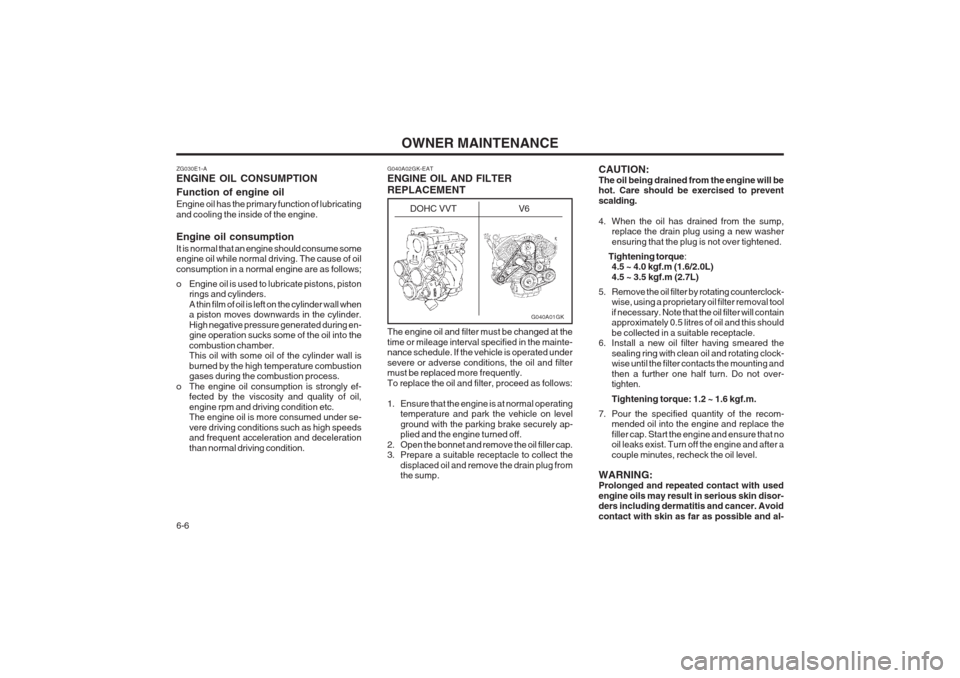
OWNER MAINTENANCE
6-6 CAUTION: The oil being drained from the engine will be hot. Care should be exercised to prevent scalding.
4. When the oil has drained from the sump,
replace the drain plug using a new washer ensuring that the plug is not over tightened.
Tightening torque :
4.5 ~ 4.0 kgf.m (1.6/2.0L)4.5 ~ 3.5 kgf.m (2.7L)
5. Remove the oil filter by rotating counterclock- wise, using a proprietary oil filter removal toolif necessary. Note that the oil filter will contain approximately 0.5 litres of oil and this should be collected in a suitable receptacle.
6. Install a new oil filter having smeared the
sealing ring with clean oil and rotating clock- wise until the filter contacts the mounting and then a further one half turn. Do not over- tighten. Tightening torque: 1.2 ~ 1.6 kgf.m.
7. Pour the specified quantity of the recom- mended oil into the engine and replace the filler cap. Start the engine and ensure that no oil leaks exist. Turn off the engine and after a couple minutes, recheck the oil level.
WARNING: Prolonged and repeated contact with used engine oils may result in serious skin disor- ders including dermatitis and cancer. Avoid contact with skin as far as possible and al-
G040A02GK-EAT ENGINE OIL AND FILTER REPLACEMENT The engine oil and filter must be changed at the time or mileage interval specified in the mainte- nance schedule. If the vehicle is operated under severe or adverse conditions, the oil and filter must be replaced more frequently. To replace the oil and filter, proceed as follows:
1. Ensure that the engine is at normal operating
temperature and park the vehicle on level ground with the parking brake securely ap- plied and the engine turned off.
2. Open the bonnet and remove the oil filler cap.
3. Prepare a suitable receptacle to collect the displaced oil and remove the drain plug fromthe sump.
ZG030E1-A ENGINE OIL CONSUMPTION Function of engine oil Engine oil has the primary function of lubricating and cooling the inside of the engine. Engine oil consumption It is normal that an engine should consume some engine oil while normal driving. The cause of oil consumption in a normal engine are as follows;
o Engine oil is used to lubricate pistons, piston
rings and cylinders. A thin film of oil is left on the cylinder wall when a piston moves downwards in the cylinder. High negative pressure generated during en- gine operation sucks some of the oil into the combustion chamber. This oil with some oil of the cylinder wall is burned by the high temperature combustion gases during the combustion process.
o The engine oil consumption is strongly ef- fected by the viscosity and quality of oil, engine rpm and driving condition etc. The engine oil is more consumed under se- vere driving conditions such as high speeds and frequent acceleration and deceleration than normal driving condition.
G040A01GK
DOHC VVT V6
Page 116 of 140

OWNER MAINTENANCE 6-11
Use only the approved transmission lubricant. The recommended lubricants are complete in themselves and the use of additives is neither required nor recommended. The use of additives may invalidate the vehicle warranty. Transmission Lubricant Level Checking
Ensure that the vehicle is parked on level ground with the parking brake firmly applied and the engine cool. Remove the level plug from the transmission when lubricant should begin to drip from the level hole. If the level is low and no lubricant is seen to drip, add the required quantity of lubricant and replace the plug.
SG110A1-E AUTOMATIC TRANSMISSION FLUID The automatic transmission fluid level should be checked and changed at those intervals pre- scribed in the maintenance schedule. It is of paramount importance that only the specified fluid is used when replenishing or changing the fluid. The use of other fluids may irreparably damage the transmission and invalidate the manufacturers warranty. In addition the ingress of dirt or lint may prevent correct functioning of the transmission and care must be exercised to prevent the ingress of such matter. CAUTION: The transmission fluid level must be checked with the engine running and at normal oper- ating temperature and therefore care must be exercised to prevent injury occurring through contact with rotating or hot parts of the en- gine. G110B03A-AAT Recommended Fluid Your Hyundai automatic transaxle is specially designed to operate with DIAMOND ATF SP-
III,
SK ATF SP- III.
Damage caused by a nonspecified fluid is not covered by your new vehicle limited warranty. G110D02GK-EAT Transmission fluid level checking The vehicle must be parked on level ground with the parking brake firmly applied and the engine at normal operating temperature. (Normal operat- ing temperature will only be achieved when the vehicle has been driven for 6 miles or more). With the engine idling and the footbrake applied, the transmission selector should be moved from the "P" position through to the "L" position and back to the "N" or "P" position. Open the bonnet and remove the transmission dipstick, remembering that care must be exer- cised to prevent injury occurring through contact with hot or rotating parts of the engine. Wipe the dipstick, replace it fully and promptly remove it again. The fluid level should be be- tween the upper and lower marks. Fluid need only be added if the level is at or below the lower mark and must never be increased above the
DOHC VVT V6
HGK212
Page 118 of 140
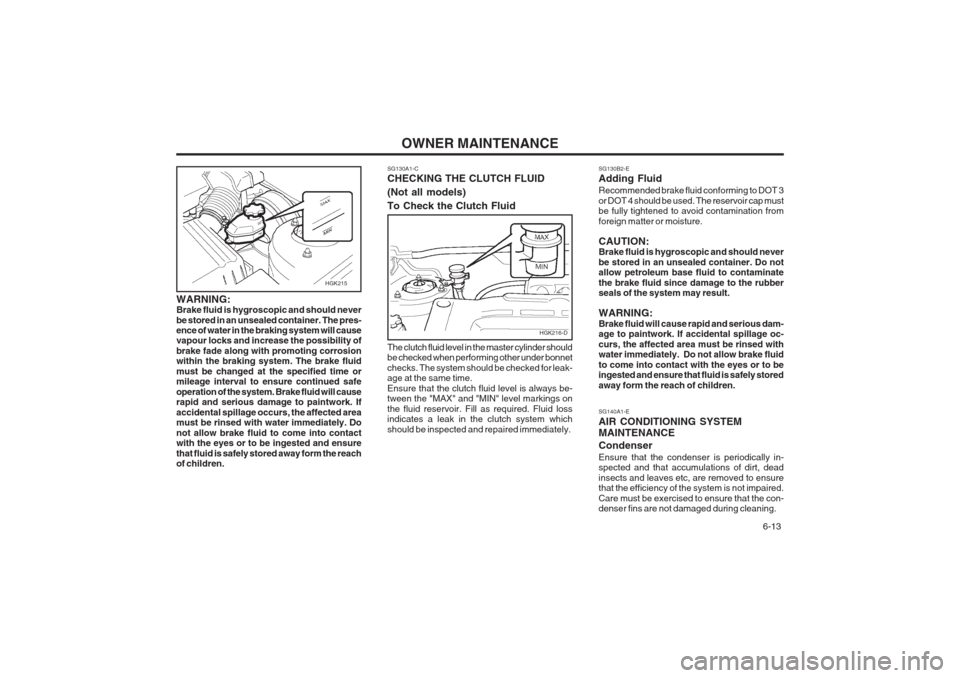
OWNER MAINTENANCE 6-13
WARNING: Brake fluid is hygroscopic and should never be stored in an unsealed container. The pres- ence of water in the braking system will causevapour locks and increase the possibility of brake fade along with promoting corrosion within the braking system. The brake fluid must be changed at the specified time or mileage interval to ensure continued safe operation of the system. Brake fluid will cause rapid and serious damage to paintwork. If accidental spillage occurs, the affected area must be rinsed with water immediately. Do not allow brake fluid to come into contact with the eyes or to be ingested and ensure that fluid is safely stored away form the reach of children. SG130A1-C CHECKING THE CLUTCH FLUID (Not all models)To Check the Clutch Fluid The clutch fluid level in the master cylinder should be checked when performing other under bonnet checks. The system should be checked for leak- age at the same time. Ensure that the clutch fluid level is always be- tween the "MAX" and "MIN" level markings on the fluid reservoir. Fill as required. Fluid loss indicates a leak in the clutch system which should be inspected and repaired immediately.
SG130B2-E Adding Fluid Recommended brake fluid conforming to DOT 3 or DOT 4 should be used. The reservoir cap must be fully tightened to avoid contamination from foreign matter or moisture. CAUTION: Brake fluid is hygroscopic and should never be stored in an unsealed container. Do not allow petroleum base fluid to contaminate the brake fluid since damage to the rubber seals of the system may result. WARNING: Brake fluid will cause rapid and serious dam- age to paintwork. If accidental spillage oc- curs, the affected area must be rinsed with water immediately. Do not allow brake fluid to come into contact with the eyes or to be ingested and ensure that fluid is safely stored away form the reach of children. SG140A1-E AIR CONDITIONING SYSTEM MAINTENANCE Condenser Ensure that the condenser is periodically in- spected and that accumulations of dirt, dead insects and leaves etc, are removed to ensure that the efficiency of the system is not impaired. Care must be exercised to ensure that the con- denser fins are not damaged during cleaning.
HGK215
HGK216-D
Page 119 of 140
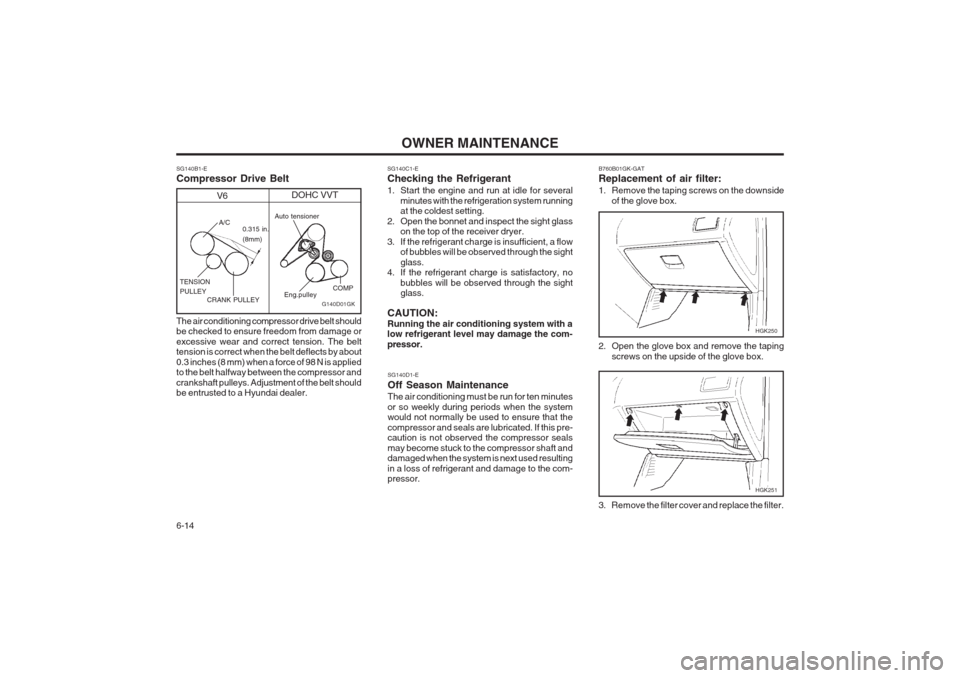
OWNER MAINTENANCE
6-14
SG140B1-E Compressor Drive Belt The air conditioning compressor drive belt should be checked to ensure freedom from damage or excessive wear and correct tension. The belt tension is correct when the belt deflects by about 0.3 inches (8 mm) when a force of 98 N is applied to the belt halfway between the compressor and crankshaft pulleys. Adjustment of the belt should be entrusted to a Hyundai dealer.
SG140C1-E Checking the Refrigerant
1. Start the engine and run at idle for several
minutes with the refrigeration system running at the coldest setting.
2. Open the bonnet and inspect the sight glass on the top of the receiver dryer.
3. If the refrigerant charge is insufficient, a flow of bubbles will be observed through the sight glass.
4. If the refrigerant charge is satisfactory, no
bubbles will be observed through the sight glass.
CAUTION: Running the air conditioning system with a low refrigerant level may damage the com- pressor.
A/C
CRANK PULLEY
TENSION PULLEY 0.315 in. (8mm)
G140D01GK
V6
DOHC VVT
Auto tensioner
Eng.pulleyCOMP
SG140D1-E Off Season Maintenance The air conditioning must be run for ten minutes or so weekly during periods when the system would not normally be used to ensure that the compressor and seals are lubricated. If this pre- caution is not observed the compressor seals may become stuck to the compressor shaft and damaged when the system is next used resulting in a loss of refrigerant and damage to the com- pressor. B760B01GK-GAT Replacement of air filter:
1. Remove the taping screws on the downside
of the glove box.
HGK250
HGK251
2. Open the glove box and remove the taping
screws on the upside of the glove box.
3. Remove the filter cover and replace the filter.
Page 122 of 140
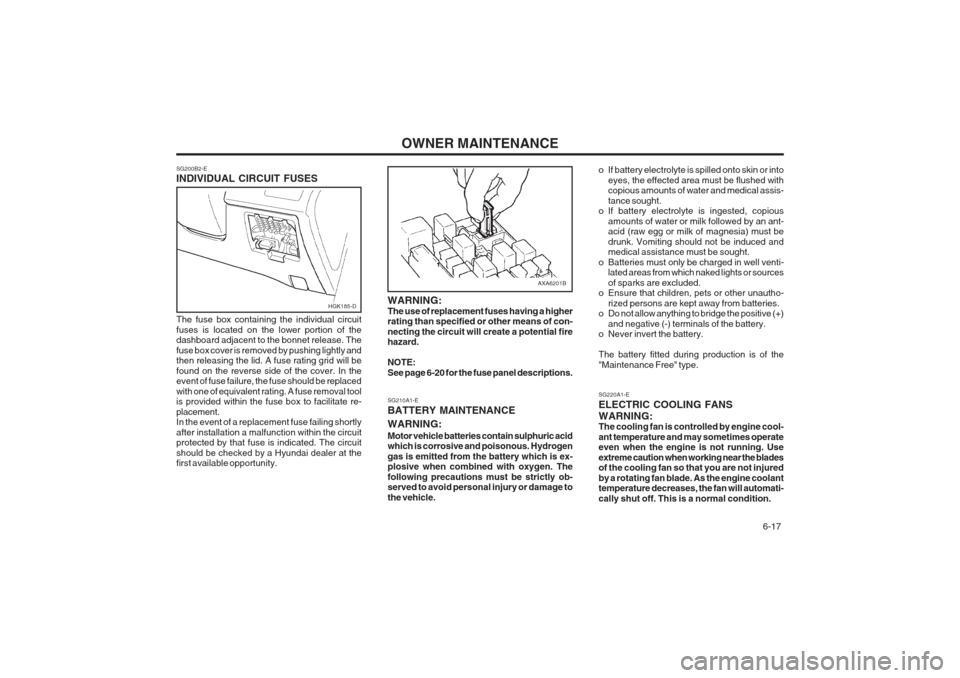
OWNER MAINTENANCE 6-17
SG200B2-E INDIVIDUAL CIRCUIT FUSES The fuse box containing the individual circuit fuses is located on the lower portion of the dashboard adjacent to the bonnet release. The fuse box cover is removed by pushing lightly and then releasing the lid. A fuse rating grid will be found on the reverse side of the cover. In the event of fuse failure, the fuse should be replaced with one of equivalent rating. A fuse removal tool is provided within the fuse box to facilitate re- placement. In the event of a replacement fuse failing shortly after installation a malfunction within the circuit protected by that fuse is indicated. The circuit should be checked by a Hyundai dealer at the first available opportunity.
AXA6201B
WARNING: The use of replacement fuses having a higher rating than specified or other means of con- necting the circuit will create a potential fire hazard. NOTE: See page 6-20 for the fuse panel descriptions. SG210A1-E BATTERY MAINTENANCE WARNING: Motor vehicle batteries contain sulphuric acid which is corrosive and poisonous. Hydrogen gas is emitted from the battery which is ex- plosive when combined with oxygen. The following precautions must be strictly ob- served to avoid personal injury or damage to the vehicle.
HGK185-D
SG220A1-E ELECTRIC COOLING FANSWARNING: The cooling fan is controlled by engine cool- ant temperature and may sometimes operate even when the engine is not running. Use extreme caution when working near the blades of the cooling fan so that you are not injured by a rotating fan blade. As the engine coolant temperature decreases, the fan will automati- cally shut off. This is a normal condition.
o If battery electrolyte is spilled onto skin or into
eyes, the effected area must be flushed with copious amounts of water and medical assis- tance sought.
o If battery electrolyte is ingested, copious
amounts of water or milk followed by an ant- acid (raw egg or milk of magnesia) must be drunk. Vomiting should not be induced and medical assistance must be sought.
o Batteries must only be charged in well venti- lated areas from which naked lights or sources of sparks are excluded.
o Ensure that children, pets or other unautho-
rized persons are kept away from batteries.
o Do not allow anything to bridge the positive (+)
and negative (-) terminals of the battery.
o Never invert the battery. The battery fitted during production is of the "Maintenance Free" type.
Page 137 of 140

INDEX10-1
C CARE OF CASSETTE
TAPE ........................................................... 1-64
CARE OF DISC ................................................................................ 1-64
CARE OF SEAT BELTS .................................................................. 1-11
CATALYTIC CONVERTOR OPERATING PRECAUTIONS .......7-1~7-2
CENTRAL DOOR LOCK .................................................................... 1-4
CHANGING A FLAT TYPE ................................................................ 3-3
CHECKING THE CLUTCH FLUID ...................................................6-13
CHILD RESTRAINT SYSTEM ......................................................... 1-13
CIGAR LIGHTER .............................................................................. 1-36
CLUTCH PEDAL FREEPLAY .......................................................... 6-15
COMBINATION IGNITION SWITCH AND STEERING LOCK .......... 2-2 CRUISE CONTROL ......................................................................... 1-48
D DAILY OPERATING CHECKS ........................................................... 6-4
DEFROSTING/DEMISTING ............................................................. 1-55
DIGITAL CLOCK .............................................................................. 1-36
DOOR LOCKS .................................................................................... 1-2
DOOR WINDOWS .............................................................................. 1-6
DRINK HOLDER .............................................................................. 1-37
DRIVE BELTS .................................................................................. 6-16
DRIVING FOR ECONOMY .............................................................. 2-10
JK000A2-EAT 10. INDEX A AIR BAG
........................................................................................... 1-18
AIR CONDITIONING SWITCH ......................................................... 1-54
AIR CONDITIONING SYSTEM MAINTENANCE ............................6-13
AIR CLEANER ELEMENT REPLACEMENT ..................................... 6-9
AIR FILTER ...................................................................................... 1-61
ANTENNA ......................................................................................... 1-66
ANTI-LOCK BRAKE SYSTEM ........................................................... 2-8
AUTOMATIC TRANSMISSION FLUID ............................................. 6-11
AUTOMATIC TRANSMISSION .......................................................... 2-5
B BATTERY MAINTENANCE .............................................................. 6-17
BEFORE FOLDING THE REAR SEATS ........................................... 1-9
BEFORE STARTING THE ENGINE .................................................. 2-2
BONNET RELEASE ......................................................................... 1-44
BRAKE PEDAL FREEPLAY ............................................................. 6-16
BRAKE SYSTEM CHECKING ......................................................... 6-12
10